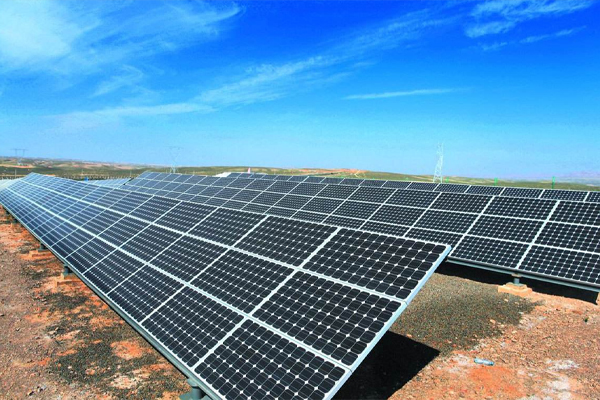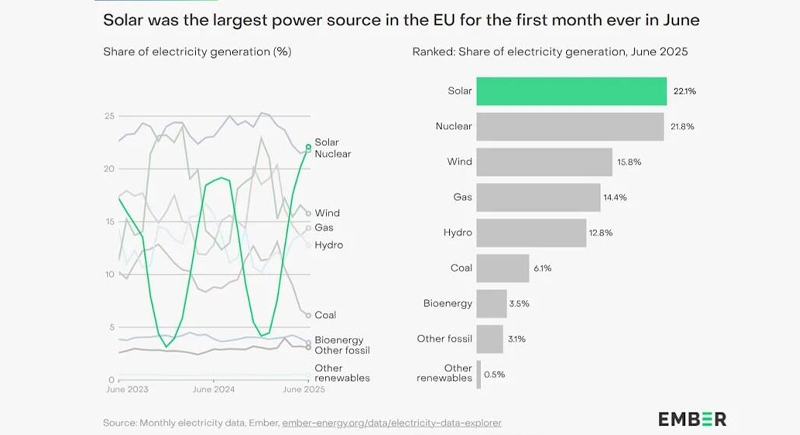VIDEO & CENTER

In June 2025, solar energy became the largest source of electricity in the European Union for the first time. In May and June, records for photovoltaic and wind power generation were constantly being broken, and coal-generated electricity dropped to its historical lowest level.

Ember found that solar energy became the largest source of electricity in the European Union for the first time last month, and the solar power generation in several countries set new records. The think tank stated that wind power generation reached a record high in May and June.
In June, solar power generation accounted for 22.1% (45.4 terawatt-hours) of the total electricity generation in the European Union, surpassing any other energy source, with a year-on-year growth of 22%. Nuclear power generation ranked second, accounting for 21.8% (44.7 terawatt-hours), followed by wind power, accounting for 15.8% (32.4 terawatt-hours).
Ember's senior energy analyst, Chris Rosslowe, said that the current biggest opportunity lies in increasing energy storage and flexible power plants, extending the use of renewable energy to the morning and evening hours, because during these two periods, fossil fuels still cause high electricity prices.
At least 13 EU countries set monthly solar power records.
Against the backdrop of a continuous surge in photovoltaic installation capacity, the solar power generation in at least 13 countries reached record highs. These countries include Bulgaria, Croatia, Greece, Slovenia, and Romania.
In May and June, the proportion of wind power reached historical highs, at 16.6% (33.7 TWh) and 15.8% (32.4 TWh) respectively.
It was reported that strong photovoltaic power generation helped the power system cope with the higher demand brought about by the heat wave sweeping across the African continent at the end of the month.
In May and June, wind farms produced 16.6% (33.7 TWh) and 15.8% (32.4 TWh) of the electricity in the EU, setting new historical highs for two months. Notably, the wind conditions were relatively poor at the beginning of the year. Although the installed capacity of wind power continued to increase over the past year, the wind conditions improved and became the main driving force. Several large offshore wind farms have been put into operation.
Coal prices dropped to the lowest level in history.
Due to the high renewable energy power generation in June, the proportion of coal in the EU's electricity fell to the lowest level in history. The total amount of fossil fuel power generation was also very low, but it showed an upward trend throughout the first half of the year compared to the first half of the previous year.
In June, coal power generation accounted for only 6.1% (12.6 TWh) of the EU's power generation, lower than 8.8% in the same period last year.
The proportion of coal power in the EU was the largest (79% in June) in two countries, both of which reached new historical lows in June. Among them, Germany's coal power generation accounted for only 12.4% (4.8 terawatt-hours) of its total power generation, while Poland was 42.9% (5.1 terawatt-hours). Four other countries also recorded new historical lows for coal power generation in June: the Czech Republic (17.9%), Bulgaria (16.7%), Denmark (3.3%), and Spain (0.6%), which is gradually phasing out coal.
In June, fossil fuel power generation accounted for 23.6% (48.5 terawatt-hours) of the EU's power generation, slightly higher than the historical low of 22.9% in May 2024. Nevertheless, the fossil fuel power generation in the first half of 2025 still increased by 13% (45.7 terawatt-hours) compared to the first half of 2024, mainly due to the 19% (35.5 terawatt-hours) increase in natural gas power generation. Hydropower (affected by drought) and wind power generation were lower than last year, and the electricity demand continued to increase.
Electricity demand has been continuously rising. In the first half of 2025, the EU's electricity consumption was 1.31 terawatt-hours, an increase of 2.2% compared to the same period last year.














